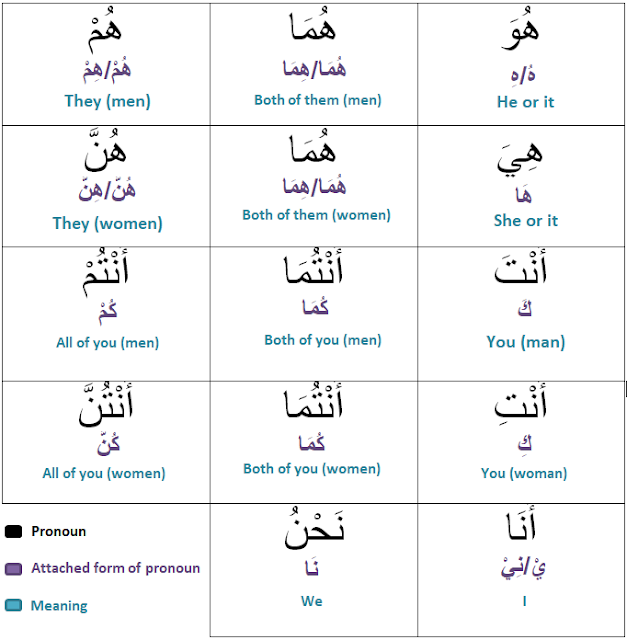Isms: Lesson 3 (Gender)
Quick recap:
There are
four properties of isms (nouns).
1. Status: rafa’
(doer), nasb (detail), jarr
2. Number:
Singular, pair, plural
3. Gender
4. Type
In the
previous lessons we discussed about the first two properties of isms, status
and number. Today, we are going to be looking at the third property which is,
‘gender’.
Every ism
(noun) in Arabic has a gender. The gender could be masculine (Muzakkar) or feminine
(Mu-annas). The general rule in Arabic is that a word is always masculine,
unless it’s proven to be feminine. Today we will be looking at just one common
way a word could be feminine. And that is simply by adding a round ‘thaa’ to
the end of a word. The examples below show how that happens.
مُسْلِمٌ à مُسْلِمَةٌ
Muslim
man Muslim woman
نَصِحٌ à نَاصِحَةٌ
Advisor
(male) Advisor (female)
طَالِبٌ à طَالِبَةٌ
Student
(male) Student
(female)
Likewise, we
can make the whole “Muslim chart” we learned in the previous lesson feminine,
by adding ‘thaa’ to the end of each word. Shown below is the original ‘Muslim
chart’ where all the words are masculine and then the feminine Muslim chart.
As you can
notice the first two columns only differs by ‘thaa’ added at the end. The last
column is a little different for the feminine chart. Rafa’ form of the plural
ends with ‘AATUN’ sound while the nasb and jarr forms end with ‘AATIN’ sound.
Memorize
both charts until you are thorough with the patterns. Memorize the feminine
chart by reading like, muslimathun, muslimathan, muslimathin, muslimathaani,
muslimathaini, muslimathaini, muslimaathun, muslimaathin, muslimaathin. Recite it
5 times and see if you can read without looking.
Memorize the
charts and do the exercise below.
Exercise:
Recite both the
patterns given in the muslim charts for the words given below
مُؤْمِنٌ
مُجَاهِدٌ
مُخْبِرٌ
مُنَافِقٌ
****************************************************************
ކުރީގެ ފިލާވަޅުތަކަށް އަވަސް ނަޒަރެއް:
ކޮންމެ 'އިސްމް' އެއްގައި (ނަމެއްގައި) 4 ސިފައެއްވެއެވެ.
މަޤާމް: ރަފަޢް (ކަންކުރާ ފަރާތް)، ނަޞްބަ (ތަފްޞީލު)، ޖަރް
ޢަދަދު: މުފްރަދް (އެކަތި)، މުޘައްނާ (ދެ އެއްޗެއް)، ޖަމްޢު (ދެއެއްޗަށްވުރެ
ގިނަ)
ޖިންސު
ވައްތަރު
ކުރީގެ ފިލާވަޅުތަކުގައި އަހަރުމެން ދަސްކޮށްފައިވަނީ އިސްމްތަކުގެ ފުރަތަމަ
ދެ ސިފަ ކަމަށްވާ 'މަޤާމް' އާއި 'ޢަދާދު' އާއި ބެހޭގޮތުންނެވެ. މިއަދު އަހަރުމެން
ބަލާލާނީ އިސްމްތަކުގެ ތިންވަނަ ސިފަ ކަމަށްވާ 'ޖިންސް' އަށެވެ.
ޢަރަބި ބަހުގައި ކޮންމެ އިސްމްއަކަށް ވެސް ޖިންސެއްވެއެވެ. އެއީ ފިރިހެން
(މުޒައްކަރު) އެހެންނޫނީ އަންހެން (މުއައްނަޘް) ޖިންސެވެ. ޢަރަބި ބަހުގެ ޤަވާޢިދު
ބުނާ ގޮތުން ޢާއްމުގޮތެއްގައި ހުރިހާ ބަހަކީ ވެސް ފިރިހެން ބަސްތަކެވެ. އެ ބަސް
'އަންހެން' ކުރުވާ ސަބަބެއްނެތް ނަމައެވެ. މިގޮތުން މިއަދު އަހަރުމެން ބަލާލާނީ
ބަހެއް 'އަންހެން' ވާ ޢާއްމު އެންމެ ގޮތަކަށެވެ. އެއީ ބަހެއްގެ ފަހަތަށް 'ތާ' އެއް
ލިޔުމެވެ.
މިސާލު:
ފާހަގަވާނެ ފަދައިން ދެ ތާވަލުގެ މުފްރަދާއި މުޘައްނާގެ
ރޮނގު ތަފާތު ވަނީ ހަމައެކަނި އަންހެން ބަސްތަކުގެ ފަހަތަށް އިތުރުކުރެވިފައިވި
'ތާ' އިންނެވެ. ޖަމްޢުގެ ރޮނގު އަންހެން ތާވަލުގައި ކުޑަކޮށް ތަފާތެވެ. އެ
ރޮނގުގައި ރަފަޢްގެ މަޤާމުގައިވާ ބަސް 'އާތުން' އަޑުން ނިމޭއިރު ނަޞްބް އާއި ޖަރް
ގެ މަޤާމުގައިވި ބަސްތައް ނިމެނީ 'އާތިން' ގެ އަޑުންނެވެ.
މި ދެ ތާވަލުގެ ބަސްތަކުގައި ހިމެނޭ އަޑުތަކަށް
ފަރިތަވަންދެން ދެ ތާވަލުވެސް ހިތުދަސްކުރާށެވެ. އަންހެން ތާވަލު މި ފަދައިން
ކިޔާށެވެ. މުސްލިމަތުން، މުސްލިމަތަން، މުސްލިމަތިން، މުސްލިމަތާނި،
މުސްލިމަތައިނި، މުސްލިމަތައިނި، މުސްލިމާތުން، މުސްލިމާތިން، މުސްލިމާތިން.
މިހެންނެވެ. 5 ފަހަރު ކިޔާފައި އަމިއްލައަށް ނުބަލައި ކިޔޭތޯ ބަލާށެވެ.
ދެ ތާވަލު ނުބަލައި ދަސްކުރުމަށްފަހު ތިރީގައި މިވާ
ފަރިތަކުރުން ހަދާށެވެ.
ފަރިތަކުރުން:
ތިރީގައިވާ ބަސްތައް ދެ ތާވަލަށް ފައްތައިގެން ކިޔާށެވެ.
مُؤْمِنٌ
مُجَاهِدٌ
مُخْبِرٌ
مُنَافِقٌ







السلام عليكم ورحمة الله وبركاته ukhutha...alah arabi dhaskura kudhinnah olhidhaane hen hyvany Arabic namaa dhivehi nan dhima nuve huryma...
ReplyDeleteWa'alaikumussalaam wa rahmathullahi. jana Arabi dhaskuri thajuribaa ah visnaafa mi genesdheny. jana ves hedhi online course ga furathama Arabi basthah beynun nukurevey. English basthakun mulhin kiyevy. e concept thah fahum veema Arabi basthah beynun kuran feshy :)
DeleteArabi bahaa dhivehi nan dhimaa nuve ey thi maana kurany kon thankolhakun kan tafseel kohdhinun edhen :)
Mi buny kiyava firihen kuhjja aa dhimaga thalibathun migothah huri vaahaka aslu egay ehen liyaairu font egothah vaakan ekam neygey kudhinnah olhi dhaanethy bunely
ReplyDeleteJazaakallah Khairan! :) mihaaru rangalhu koffin. jana eythi blog ga draft koh hedhi iruves rangalhah hury. ehenve faahaga nuvy. kuriah oiy thanuga kiyuntherinnah fenna goiy balan handhaan bahattaanan In Sha Allah :)
DeleteSorry fonteh noon ... mibuni dhivehi aa arabi liyaa iru vv dhimavey egothah
ReplyDelete